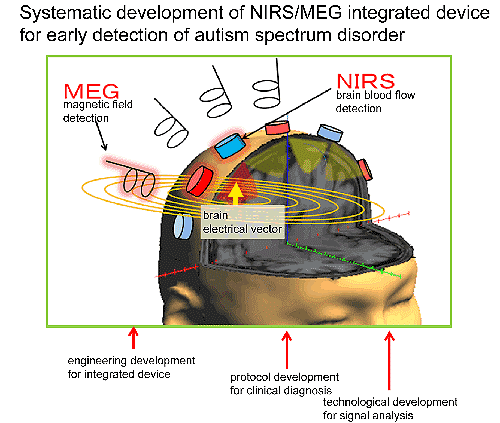| Project Leader | Yoshio MINABE Professor, Graduate School of Medical Science and School of Medicine, Kanazawa University |
||||
| U R L | http://web.kanazawa-u.ac.jp/~med20/aisatsu/pages/list.html | ||||
|
|||||
First, we develop an integrated MEG and NIRS device optimized for the early diagnosis of ASD in young children. For this novel device, realization of thin-attachments utilizing optical fiber is one of the crucial technological factors. We attempt to develop new thin-attachments (5-6mm) to replace the existing thick-attachment (30 mm).
Second, we develop proper cognitive tasks which induce robust brain responses in young children and are effective in the early diagnosis of ASD. Then, we plan to collect MEG and NIRS data from ASD and normally developed young children for use in research into the relationship between these physiological signals and behavioral data. Based on this database, we will reassess these tasks and a new device for clinical application.
Third, in order to extract meaningful information from MEG and NIRS data, we will employ various kinds of signal analyses. After we establish effective analyses, we will attempt to develop easy-to-use software for the diagnosis of infantile ASD.
Our ultimate goal is to develop the world’s leading infantile brain function evaluation system for the early diagnosis of ASD on the basis of the aforementioned three processes. Our new technology and knowledge will lead to the following commercialization and service: First, commercialization of the integrated NIRS/MEG device optimized for brain research and clinical use; second, commercialization of the system for the early detection of and intervention in autism spectrum disorder using the new integrated device; and third, clinical decision support service based on this system.
Using the integrated MEG/NIRS device, we can gain more information about neurovascular coupling, which is altered during abnormal neurophysiological states, such as those found in the psychiatric disease. Then, simultaneous measurement of blood flow response and neural activity will be promising methods for the evaluation of brain disease. In the future, development of this early diagnostic system will precipitate a strong movement towards preventative medicine.
We have a competitive advantage: the MEG production site is here in Ishikawa prefecture (Japan), and NIRS comes originally from Japanese optical technology. After the completion of the integrated MEG/NIRS device and demonstration of its clinical availability, Ishikawa prefecture (Japan) will be a production site for this novel clinical device.

The Hokuriku Industrial Advancement Center